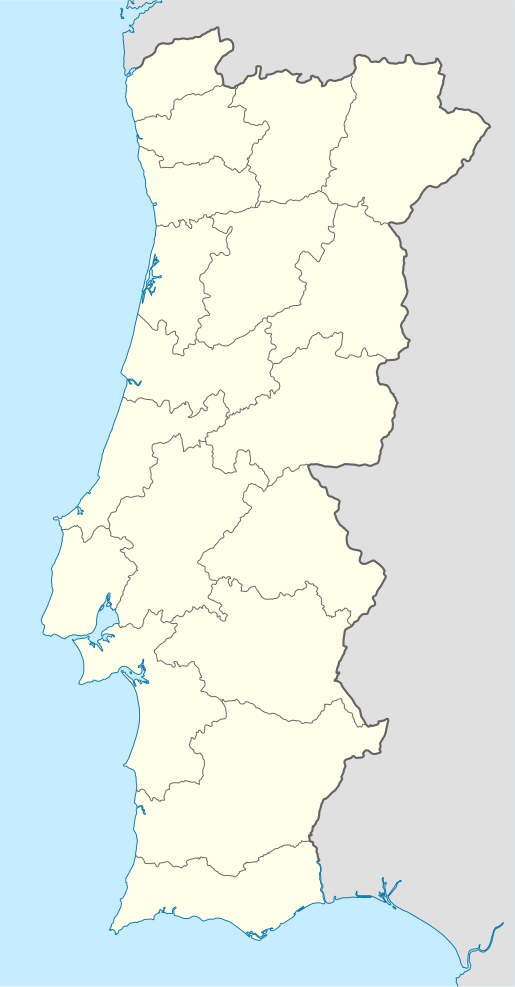Roman cities in Portugal
The territory that is modern-day Portugal would be romanized in the sequence of the Second Punic War (3rd century BCE), through the Roman conquest of the Iberian Peninsula.
The Romans would create some Roman cities, as well as romanize some previously existing settlements. As a general rule, cities with names ending in -briga are thought to have existed before the romanization of the territory, but that is not always the case (e.g., Augustobriga, near Cáceres, Spain, clearly refers to Augustus, thus it is possible that some -briga names were still being given to cities during the Roman rule).[1]
Of the 32 Mansiones in the Lusitania Province mentioned in the old Itinerarium sources, only about half are currently identified.[2]
Administrative divisions
During the era of Augustus, the Iberian Pensinsula was divided into the provinces of Lusitania, Baetica, and Tarraconensis.[3] These provinces were then divided into conventi.[4] The Lusitania province was divided into the conventi of Augusta Emerita (modern-day Mérida, in Spain), Pax Julia (Beja, Portugal), and Scalabis (Santarém, Portugal).[4] Yet, roman cities were more important than conventi in the Peninsula.[3] The two main types of roman cities were the coloniae (Roman settlements created by order of the Roman government) and the municipia (which typically existed before the romanization).[3] In the Iberian Peninsula, the terms municipia and civitas are interchangeable.[3] In 73/74 a.C.E., the lex Flavia municipalis by Vespasian would grant all urban centers of modern-day Portugal Latin rights and the distinction between urban centers (including municipia and coloniae) diminished over time after this law.[3] Everday administration was done by Aediles, Quaestores and Duoviri, which communicated with the imperial government.[3]
Villae were settlements that produced farming goods for the local markets and included multiple buildings, such as residential houses, barns, and gardens.[4] In Lusitania, most villae were located around a few cities (Lisbon, Cascais, Évora and Mérida) or spread along the southern coast.[4]
Map of Roman cities and towns in Portugal

List of Roman cities and towns in Portugal
| Latin name (variant(s)) | Type | English Name (native language(s)) |
|---|---|---|
| Aeminium | Municipium | Coimbra |
| Aquae Flaviae | Municipium | Chaves |
| Ammaia | Villa | São Salvador da Aramenha, Marvão |
| Arabriga | Alenquer | |
| Arandis | Garvão, a parish of Ourique | |
| Aretium | Alvega | |
| Aviarium, Averius[5] | Aveiro | |
| Baesuris, Esuri | Castro Marim | |
| Balsa | west of Tavira | |
| Elbocoris | Bobadela 40°21′39″N 7°53′36″W | |
| Bracara Augusta | Braga | |
| Brigantia | Bragança | |
| Caeciliana | Villa | (between Caetobriga and Malateca) |
| Caetobriga | Setúbal | |
| Calipolis | Vila Viçosa | |
| Castra Leuca | Castelo Branco | |
| Cilpes | Silves | |
| Aravorum | Civitas | Marialva Castle, near Mêda |
| Calabriga | Civitas | Monte do Castelo, Almendra |
| Cobelcorum | Civitas | Almofala, Figueira de Castelo Rodrigo |
| Centum Cellas | Villa | Colmeal da Torre, a parish of Belmonte |
| Collipo | Leiria | |
| Conimbriga | Municipium | Condeixa-a-Nova, south of Coimbra (the inhabitants of Conimbriga fled to nearby Aeminium, the ancient name of Coimbra, in 468) |
| Conistorgis | (location unknown in the Algarve or Baixo-Alentejo) | |
| Dipo | Elvas | |
| Ebora, Ebora Cerealis, Liberalitas Julia | Municipium | Évora |
| Eburobritium, Eburobrittium | Civitas | Óbidos |
| Egitandiorum, Egiptania | Municipium | Idanha-a-Velha |
| Equabona | Coina, a parish of Barreiro | |
| Guimaranis, Vimaranis | Guimarães | |
| Ipses | Alvor | |
| Lacobriga, Laccobriga | Municipium | Lagos |
| Lamecum | Lamego | |
| Lancobriga | Fiães, a parish of Santa Maria da Feira | |
| Lorica | Loriga, a parish of Seia | |
| Malateca | Marateca, a parish of Palmela | |
| Metallum Vipascense | Mina de Aljustrel, central Alentejo | |
| Mirobriga Celticorum | Santiago do Cacém | |
| Mondobriga | Alter do Chão | |
| Moron | near Santarém | |
| Myrtilis Iulia | Mértola | |
| Sellium, Nabantia, Nabancia, Selleum | Tomar | |
| Olisipo, Olisipo Felicitas Iulia, Felicitas Julia Olissipo, Ulyssipolis, Ulisseia | Municipium | Lisbon (Lisboa) |
| Ossonoba | Faro | |
| Pacensis, Pax Iulia, Pax Augusta | Colonia, Civitas | Beja |
| Portus Alacer | Portalegre | |
| Portus Cale | Porto | |
| Portus Hannibalis | Portimão | |
| Urbs Imperatoria Salacia, Bevipo | Alcácer do Sal | |
| Scalabis, Scalabis Preasidium Iulium, Scallabi Castrum, Præsidium Iulium, Scallabis Praesidium Iulium, Scallabis Iulia | Colonia | Santarém |
| Sirpe | Serpa | |
| Sinus | Sines | |
| Talabara | Alpedrinha, a parish of Fundão | |
| Talabriga | Marnel, near Águeda | |
| Tongobriga | Freixo, Marco de Canaveses | |
| Tritium | Covilhã | |
| Tubucci Aurantes | Abrantes | |
| Veniatia | Vinhais | |
| Euracini | Villa | Póvoa de Varzim |
| Vipasca | Aljustrel | |
| Vissaium | Viseu |
References
- ALBERTOS FIRMAT, M. L (1990). "Los topónimos en -briga en Hispania". Los topónimos en -briga en Hispania. 7: 131–146. ISSN 0213-2095.
- Mantas, Vasco Gil (2018). As cidades romanas de Portugal: problemática histórica e arqueológica. Imprensa da Universidade de Coimbra. ISBN 978-989-26-1566-0.
- Bowes, Kimberly Diane; Kulikowski, Michael (2005). Hispania in Late Antiquity: Current Perspectives. Brill. ISBN 978-90-04-14391-3.
- Firnigl, Anett (2013-12-01). "The settling factors of Roman villas in southern Lusitania". Acta Universitatis Sapientiae, Agriculture and Environment. 5 (1): 40–55. doi:10.2478/ausae-2014-0003.
- Infopédia. "Aveiro | Definição ou significado de Aveiro no Dicionário Infopédia de Toponímia". Infopédia - Dicionários Porto Editora (in Portuguese). Retrieved 2020-07-20.